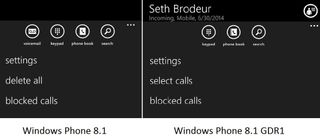You can now select multiple calls for deletion with Windows Phone 8.1 GDR1

This morning, Microsoft published a partial changelog for Windows Phone 8.1 Update 1. The listing is incomplete because it misses things like Cortana's Bluetooth integration or the new Store Live Tile. However, one area it did get right is the ability to select multiple entries on messaging, contacts and even phone calls.
Previously, in Windows Phone 8.1 and below, users could either delete everything in the call-history or delete one by one. This approach lacks the granularity that many users desire, so the ability to bring up the familiar multiple-select check boxes goes a long way to improving control over one's content.

To see the change yourself, you can just head into the Phone app and tap the ellipsis '…' near the bottom. Found in the middle is now 'select calls,' which previously read as 'delete all.' Once engaged, checkboxes should appear on the left side, letting you go through and choose multiple phone calls for deletion.
If you still would like to delete all of your entries, choose 'select calls' and now bring up the ellipsis '...' again. An option to 'select all' is now available, letting you delete all calls.

Features like call duration (details), block number and add to speed dial can be found by a long-press on a call entry. Those are not new, as they came with the original release of Windows Phone 8.1 though they are still good know in case you missed them.
Overall, the ability to select multiple calls is a minor refinement, but it helps to make people's lives easier when using Windows Phone.
Get the Windows Central Newsletter
All the latest news, reviews, and guides for Windows and Xbox diehards.

Daniel Rubino is the Editor-in-chief of Windows Central. He is also the head reviewer, podcast co-host, and analyst. He has been covering Microsoft since 2007, when this site was called WMExperts (and later Windows Phone Central). His interests include Windows, laptops, next-gen computing, and watches. He has been reviewing laptops since 2015 and is particularly fond of 2-in-1 convertibles, ARM processors, new form factors, and thin-and-light PCs. Before all this tech stuff, he worked on a Ph.D. in linguistics, watched people sleep (for medical purposes!), and ran the projectors at movie theaters because it was fun.
